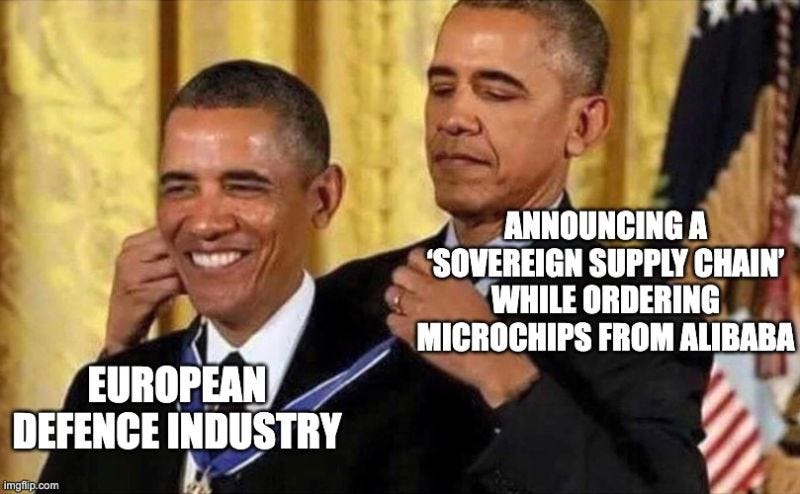Canada's Hidden $15B War Chest
Direct unallocated ITB obligations into venture
Good afternoon to the Canadian delegates attending Defence Burning Man DSEI UK 2025. In advance of DSEI, our pals at the Defence Security and Resilience Bank (DSRB) hosted an information session at Mansion House to discuss how to fund the proposed $135B multilateral bank. 180 delegates representing 39 countries were present, including four central bankers and dozens of private companies, investors, and rating agencies.
🎯 Three-Shot Burst
Ian Whytock from Tidal Venture Partners argues that Canada’s private capital markets are not just an economic lever, they are a strategic asset. In an era in which technology is defining both economic competitiveness and national security, we must re-examine our venture capital markets with a clear-eyed understanding: Shallow venture capital markets are a national disadvantage.
Reality check: Well-capitalized Canadian technology companies are not a luxury. They are a strategic imperative. Our allies already treat venture capital as part of their national security architecture. Britain’s National Security Strategic Investment Fund deploys capital into early-stage companies developing critical technologies while also backing fund managers who can identify and scale strategic innovation. In the United States, initiatives such as In-Q-Tel have been doing this for decades. All are built on the recognition that venture capital allocation is inseparable from technology development, and that technology is inseparable from sovereignty.
Oh Canada: If Canada is serious about building the capacity to procure Canadian defence solutions, we must begin by “seeding” those companies.
One of the fastest ways to close the capital gap is to activate an existing but unused policy tool: the Venture Capital Fund transaction within Canada’s Industrial and Technological Benefits (ITB) policy. ITB obligations require prime contractors on major defence procurements to invest in Canadian industry in amounts equal to the contract value. In theory, the VCF mechanism allows contractors to fulfill a portion of these obligations by investing in Canadian venture capital funds that back early-stage technology companies. In practice, restrictive limits and weak incentives have meant the policy has never been used.
There is currently more than $15-billion in unallocated ITB obligations. Reforming the VCF transaction could unlock a portion of this capital today. Targeted changes would make the mechanism competitive with other ITB options and attractive to contractors. These include removing or substantially raising the $1-million-per-company investment cap, expanding the definition of eligible Canadian companies to include those with up to 250 employees and increasing the multiplier incentive from 5x to at least 9x to match the top end of other ITB transaction types.
Bottom line: Venture capital is defence capital. We have the policy tools to mobilize this capital now. The only question is whether we will act before it is too late.
Related:
BDC is getting ready to support Canada’s defence tech sector in “a more aggressive way”
How VCs are fueling innovation in defence tech: the ongoing shift from big, expensive assets to smaller, more agile tech… IQT explains the importance of an agile arsenal:
U.S. Space Force may call on sci-fi writers, futurists to define future operating environment:
“It’d be worth looking at kind of where the venture capital community is investing to help us understand trends and technology that we may be missing” — Gillian Bussey, Space Force’s deputy chief science officer
📋 Procurement Update
New Buy Canadian policy unveiled, kinda
Prime Minister Mark Carney rolled out a series of measures on Friday that he says will transform Canada's economy into a force that can withstand the trade shocks of the Trump administration. The new measures are the first signs of industrial strategy government says will transform economy.
By November 2025, the Government will launch a new policy on Prioritizing Canadian Materials in Federal Procurement that will require domestic and foreign suppliers contracting with the federal government to source key materials from Canadian companies in defence and construction procurements exceeding a certain threshold.
There is still no timeline on a forthcoming defence industrial strategy, but Nicolas Todd, head of the Canadian delegation to the NATO industrial advisory group and VP of CADSI argues that Canada must move from defence procurement to defence production.
💾 Canada’s first Defence Tech Hackathon
CSIS is cautioning tech startups about pitching at events organized by China… The spy agency cleared our opening joke about this, right after they redacted everything except the punchline, so…
September 20 in Toronto at the DMZ
🚨 Participants have been confirmed. Special guests are being teed up. And we are cordially inviting you to express interest in joining for the pitching, judging, and awarding of the $10K cash prize generously provided by NordSpace, as well as the VIP reception to follow. To join us, sign up here — space is limited.
🤝 Sovereign Capability
Dominion Dynamics unveils Arctic Training Centre partnership
Ottawa-based defence tech firm Dominion Dynamics is partnering with the Arctic Training Centre (ATC) in Whitehorse to develop and test its systems designed to help defend the Canadian North. Dominion was founded in June and has already raised a substantial pre-seed round, backed exclusively by Canadian private capital, including Golden Ventures, Garage Capital, and strategic angel investors. The Dominion platform connects off-the-shelf sensors across land, sea, air, and space into a data fabric for coordination and data sharing across allied networks.
The ATC gives Dominion a permanent installation in a near-Arctic environment where it can test its tech and demonstrate to potential customers in the Canadian Forces.
Related:
Northern Achilles heel: How one major project is vying to be fast-tracked by the federal government… Canada’s Far North isn’t a postcard from the past. It’s the key to our future… The far north has become NATO’s soft underbelly… The Geopolitics of Quantum Sensors, Security, and the Mitigation of Climate Change in the Arctic and High North
UK to kick off new defence industrial strategy with £250mn… Tech leader turned UK investment minister quits just weeks before major summit
Trump ‘going to work something out’ in having Canada included in the Golden Dome… Telesat to offer blocks of satellite bandwidth to DoD for Golden Dome… Made-in-Canada EV batteries could be repurposed for defence… Firefly to carry Canada’s first lunar rover in 2029… General Atomics and Kepler Communications Successfully Demonstrate Air-to-Space Optical Communications Capability
Canadian think tank report calls on NATO to counter authoritarian manipulation, disinformation… A podcast discussion on the proposed defence procurement agency… Canada’s border security bill risks scaring off new business, critics warn
IDEaS is calling on Canadian innovators to design mission-ready drones. The program’s Drone surge: Scaling tactical Uncrewed Aerial Systems manufacturing for modern defence challenge is now live… Early bird registration is open now for the inaugural Building Defence - DND & DCC Industry Day on November 13… ONE9 and Invest Ottawa join forces with Area X.O partnership
⚔️ Combat Readiness
Tanks Were Just Tanks, Until Drones Made Them Change
When Russia launched its full-scale invasion of Ukraine in 2022, the two sides’ tank divisions looked much as they did during the Cold War. Now, Russia’s and Ukraine’s Soviet-era tanks rumble across the battlefield covered in anti-drone nets and spikes, dangling chains and unwieldy cages.
Bottom line: The armor changes began early in the war after Ukrainian forces used U.S.-supplied anti-tank missiles to strike Russian tanks directly from above, piercing weaker points in vehicles’ armor.
To counter the explosive projectiles, Russian tank crews began mounting homemade cages above their turrets to cushion the tanks from blasts. Other Russian units already had cages on their tanks, anticipating strikes from above.
Since then, the battlefield has completely changed. It is now driven by small, cheap first-person-view (F.P.V.) drones that can be used like homing missiles.
Related:
AI-Powered Drone Swarms Have Now Entered the Battlefield… The Defense Intelligence of the Ministry of Defense of Ukraine reported that the share of Chinese parts in the Shahed drones had reached 60-65% as of May
Armaments Center partners with IQT to boost national security innovation
Delian Alliance Industries builds autonomous Anti-Access/Area Denial (A2/AD) systems that connect “any sensor to any effector” to detect and neutralize threats across land, sea, and air
French hospitals told to prepare for war in Europe by next year in leaked Government letter
Just about two months after reports first surfaced that a super-stealthy UK startup had raised about $100M at a $400M valuation to build missile and drone defense systems for Europe, Cambridge Aerospace is officially out in the open… Tiberius raises $4.5M for Defence-as-a-Service
US SECNAV moves to consolidate Navy’s unmanned offices, pauses ‘all’ robotic contracting activities
🍁 Special Guest POV
Toronto-born James Appathurai, former NATO Deputy Assistant Secretary General for Innovation, Hybrid and Cyber, has recently been appointed head of NATO DIANA. His special message for community members of The Icebreaker on the topic of defence procurement:
Prime Minister Carney has announced a new Defence Procurement Agency at the heart of accelerating procurement, in tandem with increased defence spending to meet NATO targets. Accelerating adoption of innovative technologies, from SMEs, is going to be central to that, in all NATO countries, because that is where a lot of innovation is happening – and because there is simply no way traditional defence industry will be able to provide all the capabilities and effects needed, in time, no matter how much money is thrown at them.
NATO is adopting, and promoting in member states, a range of best practices to accelerate adoption. These include making legal frameworks more flexible, for example to allow for single source or non-competitive bids. US OTA is an example that has worked. NATO can now sole source a product from a company that has developed a prototype as part of the NATO DIANA cohort, and make it available to all Allies. Strong audit or other controls must of course be in place, but rapid contracting is essential; there is no point in contracting timelines which by definition make it impossible to acquire a product before it is obsolete or the company is bankrupt, and that is where we are now in many NATO countries.
Another step is to bring defence innovation agencies and the defence planning and procurement divisions in defence ministries closer together. Innovation agencies go fast in part because they go alone; their culture, procedures and opportunities must be mainstreamed, and the mainstream has to speed up. NATO has reformed to put innovation into its more traditional defence investment division, and is putting NATO DIANA at the heart of the rapid adoption steps launched at the Summit in Brussels.
A third step is to issue challenges to solve problem sets, rather than releasing detailed requirements or seeking specific platforms. NATO DIANA does just that: 10 challenges a year, to get effects we need from dual use companies that haven’t been part of national Defence Industry Associations, mapped against the requirements end users have identified. This should take place at the national level also.
Fourth: ringfence flexible funding. Too often, procurement budgets are programmed for years, leaving officials no flexibility when a new product comes on the market. There should be a certain amount every year for them to experiment. We could also consider setting targets for investment in key digital technologies and emerging technologies, (e.g.: AI and data, quantum, autonomy, next-gen networks and edge computing).
Which brings us to risk aversion. The culture of risk aversion in defence procurement is legendary, and for good reason: if an official spends taxpayers money on 8 young technologies, and 2 are successfully adopted while 6 are not, they are not lauded for the 2; they are punished for the 6, sometimes losing their job or career prospects. This is the wrong approach. We should build incentives into the KPIs of procurement officials to reward risk taking at the test and experimentation stage; while opening up operational experimentation and testing to young companies, and adapting it to the iterative process that they use to improve, with feedback loops and stepped contracting to reward progress, and lighter regulations and bureaucracy for smaller companies and less expensive products.
This is only a short list of reforms that have demonstrated results. NATO, including DIANA, is ready to help Allies speed up procurement, as we are reforming ourselves as well.
Related:
NATO DIANA announces the 15 companies selected for Phase 2
NATO backs Canadian defence tech with nearly $1 million for two companies: Reaction Dynamics and Tactiql each get 300,000 euros as part of DIANA tech accelerator
🔫 Hot Shots
Buy the dip?: SpaceX knocks MDA Space out of $1.8-billion satellite deal, sending the stock down 25% in a single day (Disclaimer: This is not securities advice!)… Europe’s defence tech startups attract investment surge… Iceye: The Finnish startup at the heart of modern warfare… European innovators beat the drum for Europe setting up something similar to the US DoD's Defense Innovation Unit
Baddies on parade: China got the bad kids table together for a military parade, using the occasion to unveil weapons never before seen in public… Russian drones over Germany — why the Bundeswehr cannot shoot them down
Creative disruption: The 2025 Defense News Top 100 reveals a defense industry in the midst of a major reshuffle, driven by drones, AI, and robotics… Duncan Hills on change in the international order and what to do about it… Defense Firms Lure Recruits With Yoga, Higher Pay, Condoms
Medium rare: Next steps for US DoD to end reliance on China for rare earth elements… How the United States Lost the Rare Earth Materials War to China
Maple Leaf Façade?: If your military cupboard is hurting, you can’t throw a coat of fresh paint on a disabled tank and pretend all is good for the reviewing politician… China-backed hackers 'almost certainly' targeted Canada during theft of millions of Americans' data… Defence spending must include health spending too… Parts shortages, snarled supply chains are sidelining Canadian vehicles and troops in Latvia… Public safety minister’s phone number was in document seized during 2006 terror finance probe… The Canadian Coast Guard’s integration into National Defence is more than an organizational chart change, it’s a stress test of the digital maturity of DND/CAF
Here and there: Voters believe in a sovereign Europe more than elites… EU chief von der Leyen's plane hit by suspected Russian GPS jamming… F-47 could be airborne "faster than normal," says Boeing exec… Trump will seek 'Department of War' rebrand for Pentagon… a handy taxonomy of dual-use
What we’re reading: General perspectives on synthetic biology and food for thought related to security considerations, by Canadian co-author Andrew Hessel
⚔️ Meme Warfare
Not great, folks.
🤝 Upcoming events
The Icebreaker is partnering with York University to tackle the business of dual-use tech
On October 1, York University’s annual Ernest C. Mercier Lecture in Entrepreneurial Science — a joint initiative of the Schulich School of Business and Lassonde School of Engineering — will be co-hosted by The Icebreaker. The evening will feature a keynote by NordSpace CEO Rahul Goel, followed by a panel discussion (panelists to be announced) on dual-use tech.
Apply to attend if you are interested — spaces are limited.
Defence industrial strategy panel at GCXPO
Co-hosted by Communitech and Invest Ottawa, The Icebreaker will moderate a panel on Canada’s defence industrial strategy on September 24 at GCXPO — sign up here to attend.
If you’ve got battlefield intel, classified tips, or just want to call in an airstrike on our typos, hit “reply” and sound off. Whether it’s a new tech sighting, a rumour from the mess hall, or feedback on our comms, we want your SITREP.





